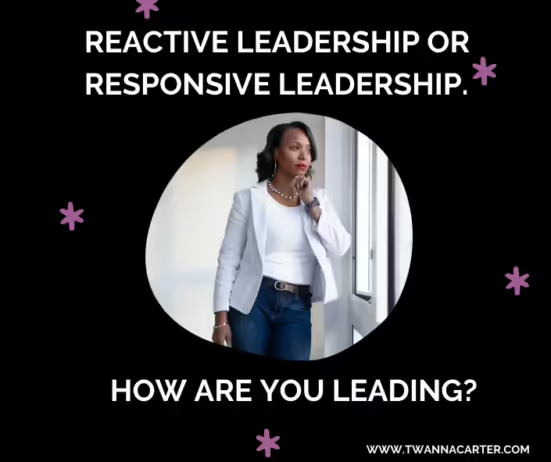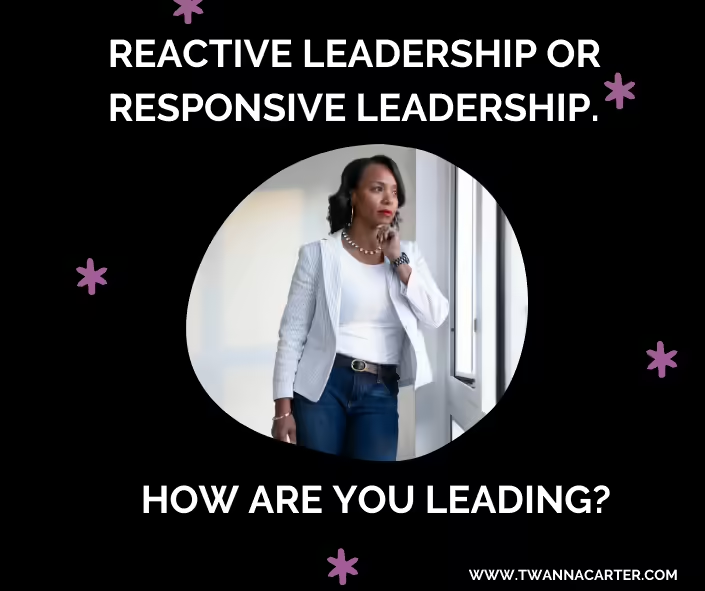October 21, 2024


Do you often feel like you’re constantly putting out fires at work, responding to one crisis after another, and barely finding time to focus on your long-term goals? If so, you’re not alone. Many leaders—especially Black women executives—find themselves stuck in a cycle of reactive leadership, where immediate challenges take precedence over strategic growth. But leadership doesn’t have to feel chaotic.
We’ll offer actionable insights to help you shift from reactive to purposeful leadership, empowering you to take control of your career with confidence and intention. Let’s explore the difference between these two leadership styles and discover strategies to help you lead with clarity, inspire your team, and achieve a better work-life balance.
What Is Reactive Leadership?
Reactive leadership tendencies refers to a leadership style where decisions and actions are dictated by immediate needs, external triggers, and unforeseen challenges. Leaders operating in this mode are often in “firefighting” mode because you’re putting out one fire or crisis after another.With little time to focus on long-term goals.
Each day you leave work feeling like all you’ve done is spin your wheels in one place. But accomplished little that matters.
Impact of Reactive Leadership:
- Increased Stress: You feel overwhelmed by a constant influx of urgent tasks.
- Short-Term Focus: Decision-making becomes limited to solving today’s problems.
- Lack of Vision: There’s little room for strategic planning, leaving career growth stagnant.
What Is Purposeful Leadership?
Purposeful leadership, in contrast, is intentional and proactive. It emphasizes aligning actions with long-term goals, core values, and strategic priorities. Purposeful leaders anticipate challenges, stay focused on the bigger picture, and inspire their teams by leading with clarity and direction.
Impact of Purposeful Leadership:
- Clarity and Focus: Decisions align with personal values and long-term career objectives.
- Stronger Teams: Teams perform better when they see a leader with clear goals.
- Improved Well-Being: Purposeful leaders are more likely to maintain a healthy work-life balance.
Signs and Symptoms of Reactive Leadership
Just as imposter syndrome has identifiable symptoms, reactive leadership also manifests in several ways:
- Chronic stress and anxiety.
- Constantly feeling “behind” or overwhelmed.
- Lack of delegation and difficulty trusting others with responsibilities.
- Decreased team morale due to inconsistent direction.
- Neglect of self-care and personal well-being.
Shifting from Reactive to Purposeful Leadership
1. Cultivate Self-Awareness
Identify the triggers that lead you to react impulsively. Are external pressures or personal fears driving your decisions? Journaling your decisions over a week can help highlight patterns.
Action Tip: Keep a log of your leadership choices and analyze whether they were reactive or proactive.
2. Align with Core Values
Clarifying your personal values and aligning your leadership with those values allows you to lead with authenticity and intention.
Action Tip: Draft a personal mission statement that reflects your career vision and values. And review it often.
3. Develop a Proactive Mindset
Adopt a forward-thinking mindset by anticipating challenges and creating systems to manage them effectively.
Action Tip: Schedule time weekly to strategize about potential challenges and how to handle them proactively.
4. Invest in Emotional Intelligence Coaching
Cultivate emotional awareness and mindfulness to better manage stress and stay calm under pressure. A whopping 98% of participants who completed Clients have Programs such as my (Strategic Success Mindset) 7-Week Mental Fitness Coaching Intensive found they increased their emotional intelligence.
Action Tip: Practice mindfulness or meditation to enhance emotional resilience.
Benefits of Purposeful Leadership
1. Career Fulfillment
Leading with intention brings clarity and makes work more meaningful, increasing career satisfaction.
2. Better Decision-Making
Purposeful leadership promotes thoughtful, strategic decision-making grounded in your long-term vision.
3. Stronger Teams
A leader with purpose inspires trust and motivates their team, fostering a collaborative environment.
4. Improved Work-Life Balance
By focusing on what matters most, you’ll find it easier to set boundaries and prioritize self-care.
Michelle’s Leadership Transformation
Michelle, a VP of Operations, struggled with reactive leadership. She spent her time managing crises and felt stuck in her career.During coaching, she clarified her long-term goal of becoming a CEO. She began setting priorities aligned with that vision and learned to delegate effectively. Within two years, she was promoted to Senior VP and experienced less stress, a more independent team, and greater career satisfaction.
7 Tips to Lead with Purpose and Intention
- Acknowledge Your Accomplishments: Recognize and celebrate your successes.
- Set Realistic Goals: Break larger goals into manageable tasks.
- Challenge Negative Thoughts: Reframe thoughts that hold you back.
- Recognize Triggers: Identify situations that push you into reactive mode.
- Step Outside Your Comfort Zone: Take small risks to grow as a leader.
- Seek Feedback: Embrace constructive feedback to grow and improve.
- Practice Self-Care: Prioritize activities that restore your energy and focus.
Final Thoughts
Shifting from reactive to purposeful leadership takes intentional effort but is transformative. By cultivating self-awareness, aligning your decisions with your values, and adopting a proactive mindset, you’ll reduce stress, inspire your team, and lead with confidence. Purposeful leadership empowers you to take control of your career and achieve the balance and fulfillment you desire.
Ready to take the next step toward purposeful leadership? Schedule a V.I.P. Roadmap session with me today, and let’s work together to align your career with your long-term goals.
FAQs: Shifting from Reactive to Purposeful Leadership
- What is the difference between reactive and proactive leadership?
Reactive leadership responds to immediate challenges, while proactive leadership anticipates issues and focuses on long-term goals. - How do I know if I’m a reactive leader?
If you feel overwhelmed by constant emergencies and struggle to focus on long-term goals, you may be operating in reactive mode. - What are the benefits of purposeful leadership?
Purposeful leadership improves decision-making, boosts career fulfillment, strengthens teams, and enhances work-life balance. - How can I align my leadership with my core values?
Start by identifying your values and creating a personal mission statement to guide your decisions. - How do I develop emotional intelligence as a leader?
Practice mindfulness, meditation, or journaling to enhance self-awareness and emotional regulation. - Can purposeful leadership help with work-life balance?
Yes, it encourages prioritization and boundary-setting, leading to better personal and professional well-being. - What is the first step toward shifting to purposeful leadership?
Begin by cultivating self-awareness—track your decisions to identify patterns and triggers.


I’m an ICF Professional Certified Coach (PCC) and executive career coach for Twanna Carter Professional & Personal Coaching, LLC. I flubbed my first career transition from the military so badly, it took me the next 10+ years to build my confidence and recover. I know what it feels like to struggle with imposter syndrome and uncertainty about my worth in the workplace. It’s why I am dedicated to empowering Black women. Helping them navigate career change and uncertainty by providing them with the tools and strategies they need to be successful. Schedule a free 30-Minute Career Solution Call today.
If you enjoyed this blog, leave a comment and consider buying me a coffee.
- Why Career Uncertainty Silently Shrinks Earning Power of Black WomenUnderstanding Career Uncertainty in Modern Professional Life Career uncertainty isn’t just confusion about what to do next. It’s an emotional… Read more: Why Career Uncertainty Silently Shrinks Earning Power of Black Women
- Why Black Women Fail at Career Pivots. Barriers and Pathways to SuccessThe Harsh Reality of Career Pivots for Black Women Right now, more than 300,000 Black women in the U.S. are… Read more: Why Black Women Fail at Career Pivots. Barriers and Pathways to Success
- 7 Powerful Strategies to Brand & Thrive After a Layoff A Stark Reality. Over 300,000 Black Women Have Been Laid Off More than 300,000 Black women have been laid off… Read more: 7 Powerful Strategies to Brand & Thrive After a Layoff
- Personal Branding for Black Women Who Are Invisible. A Transformative GuideThe Power of Personal Branding for Visibility Invisibility is exhausting and Black women know it better than anyone else.Every meeting,… Read more: Personal Branding for Black Women Who Are Invisible. A Transformative Guide
- The Worker Bee Trap for Black Women Executives. How Over-performance Keeps Us Invisible in Corporate AmericaWorker Bee. The Hidden Trap Behind “Hard Work Pays Off” Growing up, many of us were taught the same lesson:… Read more: The Worker Bee Trap for Black Women Executives. How Over-performance Keeps Us Invisible in Corporate America
- Why Storytelling is Your Secret Weapon for the C-SuiteWhy Women Executives Need Strategic Storytelling As women executives, we know how vital it is to shape our narrative and… Read more: Why Storytelling is Your Secret Weapon for the C-Suite
- 3 Branding Mistakes That Sabotage Successful Black Women LeadersWhy Personal Branding Matters More Than Ever Visibility Equals Value As a Black woman in leadership, your excellence is undeniable.… Read more: 3 Branding Mistakes That Sabotage Successful Black Women Leaders
- Executive Coaching for Black Women. Empowering Unstoppable SuccessWhy Executive Coaching Matters for Black Women In today’s fast-paced corporate world, executive coaching for Black women is more… Read more: Executive Coaching for Black Women. Empowering Unstoppable Success
- Build a Powerful Network They Say. But No One Tells You How! To build a powerful network is one of the most influential tools for professional and personal success, yet most people… Read more: Build a Powerful Network They Say. But No One Tells You How!
- 12 Tips to Successfully Changing CareersChanging careers is no longer the rare, risky leap it once was. It’s becoming a normal part of professional life.… Read more: 12 Tips to Successfully Changing Careers
- Powerful Network Secrets: Build Influence FastSecrets Revealed How to Build a Powerful Network A powerful network is one of the most useful tools for professional… Read more: Powerful Network Secrets: Build Influence Fast
- The ‘Soft Life’ Schedule: How I Rebuilt My Week Around Rest, Results, and RelationshipsOnce upon a grind, I believed that success was measured in sleepless nights, endless hustle, and a calendar packed… Read more: The ‘Soft Life’ Schedule: How I Rebuilt My Week Around Rest, Results, and Relationships
Curated Reads: Essential Books to Add to Your Personal Library
- Negotiating While Black: Be Who You Are to Get What You Want by Damali Peterman
- The Art of Negotiation: How to get what you want (every time) by Tim Castle
- Melaninated Magic: 180 Affirmations to Nurture Your Soul and Unleash Your Black Girl Joy by Twanna Carter, PhD
- I’m Not Yelling: A Black Woman’s Guide to Navigating the Workplace (Successful Black Business Women), Elizabeth Leiba.
- Crucial Conversations: Tools for Talking When Stakes Are High by Kerry Patterson, Joseph Grenny, Ron McMillan, and Al Switzler.
- Influence: The Psychology of Persuasion by Robert B. Cialdini.
- How to Win Friends and Influence People by Dale Carnegie.
- Overworked and Undervalued: Black Women and Success in America by Rosalyn D. Davis, Sharon L. Bowman, et. al.
- Power Negotiation – Getting to the Yes: Strategies to Get What You Want, When You Want It by Patrick Kennedy






![Black women executive using storytelling with her team; Why Storytelling is Your Secret Weapon for the C-Suite; find Black executive story; executive coaching for Black women; best Black executive coach NY, best executive career coach near Maryland; find Black executive coach near TX; hire personal branding consultant for black women executives, branding audit services for black female founders, branding strategy package for women of color in business, personal branding coach for black women leaders, fix my executive brand [for black women], rebranding agency for black women-led companies, LinkedIn profile rewrite service for black female executives, corporate headshot photographer specializing in black women professionals, speaker branding package for black women keynote speakers, employer branding consultant for diversity & inclusion,](https://twannacarter.com/wp-content/uploads/2025/08/Why-Storytelling-is-Your-Secret-Weapon-for-the-C-Suite_Twanna-Carter-150x150-png.webp)
![successful Black woman executive standing next to a desk; 3 Branding Mistakes that Sabotage Black Women_Twanna Carter; how to recover from a branding mistake as a black female executive, rebranding strategy after a business mistake black women, fixing a weak personal brand as a woman of color in leadership, managing online reputation for black women executives, how to position myself as an industry expert [black woman], overcoming invisibility as a black woman in corporate america; building authority and credibility as a black female leader; branding for black women who want board positions; how to communicate my value as a black woman executive, personal branding for black women seeking c-suite roles,](https://twannacarter.com/wp-content/uploads/2025/08/3-Branding-Mistakes-that-Sabotage-Black-Women_Twanna-Carter-150x150-png.webp)














+ show Comments
- Hide Comments
add a comment